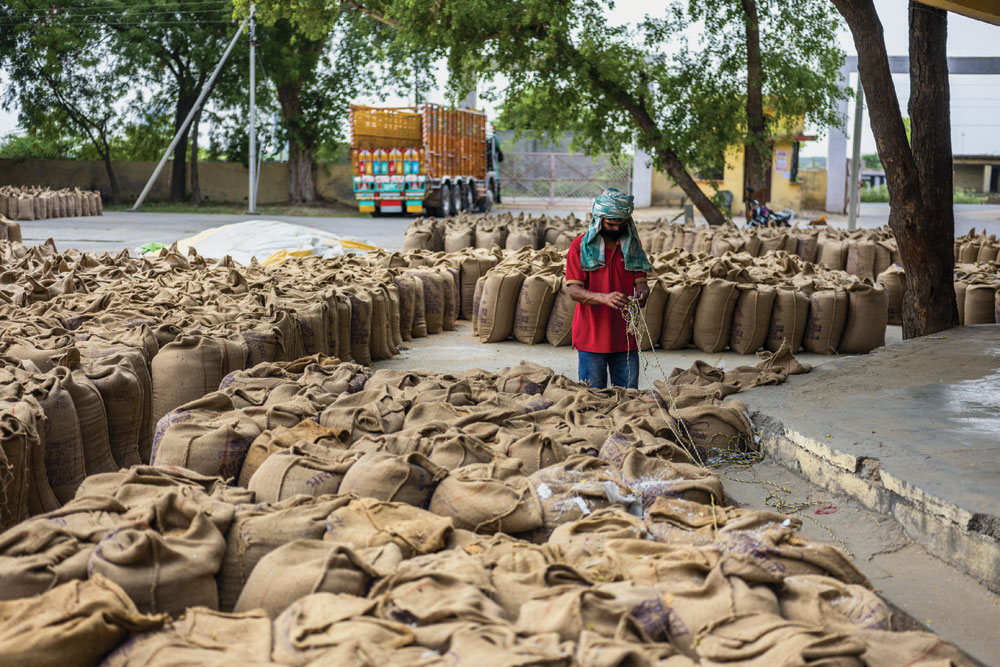Farmer Friendly
Food subsidy and minimum support price data show the persistence of the government’s generosity
 Siddharth Singh
Siddharth Singh
 Siddharth Singh
Siddharth Singh
 |
05 Feb, 2021
|
05 Feb, 2021
/wp-content/uploads/2021/02/Farmerfriendly1.jpg)
Workers dry paddy grain in North 24 Parganas, West Bengal, January 30 (Photo: Getty Images)
IN THE EXCITEMENT about the Government’s huge expenditure to spur growth in the 2021-2022 Union Budget and the slew of reforms announced in the finance minister’s speech, an extraordinary set of figures was largely ignored. Tucked away in one of the annexures of the speech was a table detailing the money spent by the Government on purchasing the crops sold by farmers. To call it money-spinner would be an understatement.
It is a dreary tactic to show the Government’s benevolence towards the largest pool of working people in India through a set of statistics. But these are contested times. A large group of farmers has effectively put a siege around Delhi that is more reminiscent of a medieval military situation than a group of citizens protesting in a democracy. The pertinence of the data in Finance Minister Nirmala Sitharaman’s speech is a product of this volatile political situation. It calls out the lie that the Narendra Modi Government is anti-farmer and that sons of the soil are about to get a raw deal.
The facts are very different as the 2021-2022 Budget shows. In the seven years from 2014-2015 to 2021-2022, with data for the latter year still rolling in, the Government spent a gigantic horde of cash on farmers: Rs 3.09 lakh crore was spent on Minimum Support Price (MSP) operations for wheat while another Rs 7.48 lakh crore was spent on MSP for paddy (rice), making for a tidy total of Rs 10.5 lakh crore. This is, to put it mildly, a mind-boggling sum.
All these extraordinary numbers were delivered by the minister in her traditional deadpan manner, “Our Government is committed to the welfare of farmers. The MSP regime has undergone a sea change to assure price that is at least 1.5 times the cost of production across all commodities. The procurement has also continued to increase at a steady pace. This has resulted in increase in payment to farmers substantially.” What could not be hidden was that the number of farmers who benefited from this huge dollop of help had more than doubled in the case of wheat (from nearly 20.5 lakh in 2016-2017 to 43.36 lakh in 2021-2022) and doubled in the case of rice as well but with much greater absolute numbers (from 76.85 lakh to an estimated 1.54 crore for the same two years).
Naysayers, being naysayers, can always say what is in the past is, well, in the past. But reading the fine print of the Budget tells us that this state of affairs is unlikely to end. If one looks at the sums allocated for food subsidy for three fiscals since 2019, the story is one of a rising level of resources being devoted to help farmers. The details on expenditure in the Budget show this clearly. Under ‘Demand 15’, the subhead where details of food subsidy are to be found, the Government allocated Rs 75,000 crore for this purpose to the Food Corporation of India (FCI) in 2019-2020. These were the ‘actuals’ for that year. If one adds another part of that demand—food subsidy for decentralised procurement under the National Food Security Act (NFSA)—another Rs 33,508 crore has been dished out for that year. That makes for a total of Rs 1.08 lakh crore. It is worth noting that this figure is lower than the actual money dished out to farmers for wheat and rice as listed in the minister’s speech. This is due to crop marketing seasons and Budgets being out of sync. But the sums involved are huge.
The last year—the year of the pandemic—witnessed a gigantic bump in the food subsidy figure: direct payment to FCI under NFSA and for decentralised procurement under NFSA tallied to Rs 4.22 lakh crore when the revised figures for 2020-2021 were released. This represented a phenomenal 266 per cent increase over the budgeted figure of Rs 1.15 lakh crore. But one can say 2020 was a horrible year and the Government did what was morally right: it fed poor citizens who had no way to get food on their own.

But even here the story, one or the other, ends up with the farmers of north India who are the main beneficiaries of Government largesse. The system is complicated: the farmers produce, FCI buys from them and then ration shops hand over food to the poor. The flow of money in the reverse direction is from the Government dishing out food subsidies to FCI and the latter giving it back to the farmers. Of course, the reverse flow is much slower and takes place over many years as state governments and FCI squabble over who owes how much. But the one thing that stands out in this story is the quaint expression ‘food subsidy’. It is actually ‘farmers’ subsidy’ and that too just a part of it. When one adds subsidies for fertilisers, fuels, seeds and many other items that remain hidden in the nooks and crannies of Budget documents, the farmer comes out not as someone who is braving cold and apathy on National Highway Number 1, but someone who is part of a well-entrenched interest group. The sums that any government is forced to shell out painfully even as it smiles and says it stands with the farmer is testimony to that.
IN JUNE LAST YEAR, at the height of the Covid-19 pandemic, Prime Minister Narendra Modi had announced the plan to roll out ‘One Nation, One Ration Card’, a scheme that would allow portability of food entitlements across India. The timing of the announcement was significant. India had just witnessed a gigantic internal migration after a stringent lockdown was announced to contain the spread of the Covid-19 virus. The Government’s administrative machinery swung into action to help migrants, to ensure availability of rations (and hence the huge jump in the food subsidy bill), but the time had come to ensure portability. The idea made economic sense as well. Workers bereft of jobs and incomes are certain to rush back to their homes as they are unlikely to go hungry there. But as the 2020 migration showed, this not only caused a huge human dislocation but an equally large economic one. Deprived of their workers, business and industries, too, entered a phase of distress. The chain of events that began with the pandemic ended up causing acute financial distress across the economic system. If only workers could stay where they worked, things would have been very different.
Fast-forward to the 2021-2022 Budget. For the coming fiscal, too, the food subsidy bill is high. It has come down from the high seen in 2020-2021 but at Rs 2.42 lakh crore, it remains 110 per cent higher than 2019-2020, the ‘normal’ year before the pandemic. This is, no doubt, due to the rollout of the ‘One Nation, One Ration Card’ plan as experts say this will lead to a higher offtake of foodgrain across states. But it is also undeniable that the Government remains committed to wheat and rice farmers of north India, who will continue to gain the most out of the Government’s purchases.
This Budget is held to lack demand-side initiatives while focusing too much on the supply side. In rural India, this distinction breaks down if too fine a point is put on it. Food subsidy, more a producers’ subsidy, keeps many north Indian states lubricated, acting as a source of demand
None of these facts, and India’s complicated and expensive system of food procurement that has evolved over time, is able to convince critics that the Government is not out to shortchange the allegedly beleaguered farmers. The fact is that reform of the system is not even on the horizon. Far from the three agriculture reform laws passed by Parliament ‘destroying’ the mandi system, the flow of money in the food economy shows the system is expanding and not contracting.
The inconsistency in the structure of argument is worth pointing out. There is by now a formidable critique of the Government’s approach to the three farm laws. What is interesting to note is that the same set of critics is saying the Government has not done enough for the poor. Looking at the bloated food subsidy bill one could indeed say that this is an anti-poor measure. Until some years ago, the same critics who today defend farmers from north India and grain commission agents—arhtiyas—used to say it was against the poor people of India. Ideally, with their championing of these farmers, they should have abandoned the anti-poor rhetoric that accompanies every Budget. In reality, successive Budgets under the Modi Government have continued giving more money in the hands of the poor and the farmers at the same time. That is the secret for continuing fiscal deficits seen over the years. This was very clearly understood as a political constraint that had to be respected if economic reforms had to even have a half-decent chance.
More substantively, the problem with this melange of criticisms is that they lack consistency. The 2021-2022 Budget is held to lack demand-side initiatives while focusing too much on the supply side. In rural India, this distinction breaks down if too fine a point is put on it. Food subsidy, which is more a producers’ subsidy, keeps the economy of many north Indian states lubricated, acting as a source of demand. Similarly, if poor citizens get food entitlements, a large part of their consumption basket is taken care of, leaving them some money to spend towards other needs, in effect, acting as something of a support for demand elsewhere.
Then, there is the issue of alleged breakdown of federal boundaries with the Centre legislating on what is claimed to be a state subject: agriculture. But here, as in the supply-versus-demand debate on the Budget, this is too much of an artificial distinction. The fact is that MSPs and their effective implementation require financial wherewithal of the kind that no individual state possesses. It is also a fact that these purely transactional, market relationships are now viewed as something of support programmes that provide public goods. Ideally, if this indeed was a federal issue, state governments should go ahead and devise their own support programmes. But this—as anyone with even a cursory familiarity with finances of state governments knows—is impossible. State governments will mouth the federal principle but quietly want the Centre to foot the bill for what they are in no position to provide. It sounds clunky and awkward but the Centre seems to be providing a local public good when it foots the exorbitant bill for food subsidy.
These systems were devised at a time when India was a fledgling and insecure nation-state. It had little money to buy food from international markets and had to establish its own systems to meet its urgent needs. But those were also days when practical concerns were kept away from partisan and toxic ideological debates. The trouble for Prime Minister Modi is that he is trying to reform a system that is hostage to special interests and critics who care little about what is rational for India.

/wp-content/uploads/2025/07/Cover-Shubman-Gill-1.jpg)












More Columns
‘Fuel to Air India plane was cut off before crash’ Open
Shubhanshu Shukla Return Date Set For July 14 Open
Rhythm Streets Aditya Mani Jha